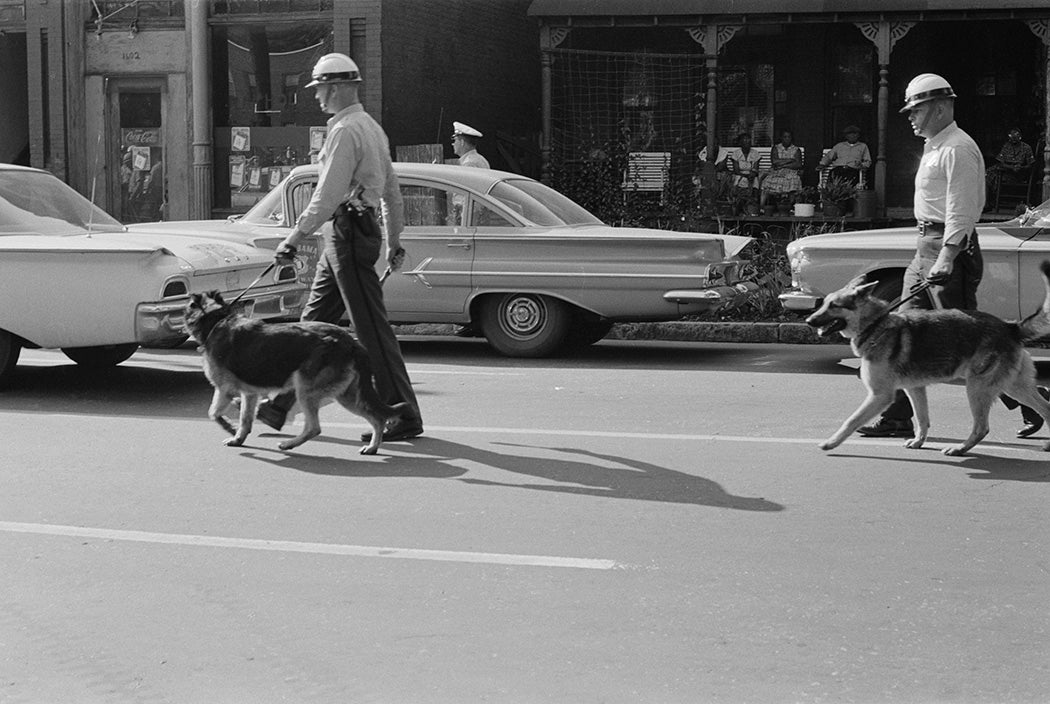Some of the most horrifically indelible images of the Civil Rights struggle show police dogs attacking young demonstrators in Birmingham, Alabama, in 1963. Birmingham became emblematic of animalistic police brutality against non-violent protestors—but it wasn’t unique at the time. And the racial weaponization of dogs isn’t just something of that time, as examples from Abu Ghraib (2004) to Ferguson (2014) show.
Scholar Tyler Wall doesn’t think it’s coincidental that K-9 units were introduced in police departments across the country during the Civil Rights era of the 1950s and 1960s, however. Quoting advocates of the day, Wall writes that dogs were deployed as tools to “civilize the savagery of urban (dis)order by pacifying urban space.” In practice, this meant dogs were deployed in the “criminalization of the so-called Negro problem,” to “police the material and symbolic boundaries of the color line,” and to enforce the dehumanization of people of color.
“The mystical power of the police dog […] was its apparent ability to recognize the boundaries dividing those bodies in need of protection—white propertied bodies—from those darker bodies prowling on the boundaries of white bourgeois order.”
There were experiments with police dogs in England as early as the 1870s and Paris in the 1910s. Police dogs appeared on the streets of New York in 1907, but law enforcement “canine corps” didn’t become institutionalized until after Brown v. Board of Education (1954) and the Montgomery Bus Boycott (1955–1956). Baltimore (1956) and St. Louis (1958) were the pioneers. By early 1960, at least twenty-four police departments had K-9 units. Many more would soon follow, by no means confined to the South.
From the White House on down, police dogs were portrayed as crime-fighters and riot-controllers. “The dog is the most potent, versatile weapon ever invented,” declared one enthusiastic Baltimore K-9 officer at the time, noting that a gun couldn’t shoot around a corner, but a dog could.
The preferred breed for such four-legged smart-weaponry was the German Shepherd/Alsatian. These were originally bred by a German at the turn of the twentieth century to have the “qualities” of the German nation as he saw them: “obedience, loyalty, courage, and discipline.” The “German police dog” thus initially a bad reputation in the US, on par with pit bulls circa 1989. Hollywood’s Rin Tin Tin—found on a World War I battlefield by a doughboy—helped change the German Shepherd’s reputation over the course of twenty-seven films starting in the silent era, while later dogs said to be Rin Tin Tin’s progeny brought the character into the television age.
The German connection was overt in Mississippi in 1961. That year, the Jackson police borrowed Happy and Rebel, two German Shepherds, from the Vicksburg police to use against Black college students staging a sit-in in a segregated public library. A local newspaper (“Police Dogs Emphasize Law, Order”) reported, and not in a critical way, that the dogs had been trained by an East German refugee who was a “former Nazi storm trooper who trained Dobermans to guard Hitler’s airports.”
Weekly Newsletter
Citing current police dog literature and fan pages, Wall notes the prevalence of terms such as “savages” to denote the non-white targets of police dogs. Racial dehumanization is thus enforced by an ideology that argues only animals can control the subhuman. Wall writes that in fact it is the “animalization of police power” that is the real mark of brutishness. In an echo of “slave” or “negro” dogs used to hunt the self-emancipated in the nineteenth century, twentieth and twenty-first century “canine terror” in race-policing “enshrines the brute instinct at the heart of police power.”
“Even with ‘post-racial reforms’ in accountability, training, and education, police dogs are still routinely deployed to attack humans, and disproportionately biting black and brown subjects,” writes Wall. He cites Justice Department reviews of the Ferguson police, Los Angeles police (where officers referred to Blacks as “dog biscuits” in the early 1990s), and Los Angeles County sheriff department, which show that Black and Latinx subjects are bitten at “astounding rates,” much higher than whites are.
“To those subject to this terror the police dog literally haunts them, often evoking in those attacked nightmares of being eaten alive,” concludes Wall.
Support JSTOR Daily! Join our new membership program on Patreon today.







